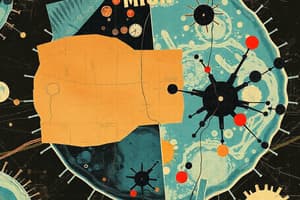Podcast
Questions and Answers
What is the function of the ribosome in the cell?
What is the function of the ribosome in the cell?
- To store genetic information
- To synthesize proteins (correct)
- To synthesize DNA
- To break down proteins
Where are ribosomes found in eukaryotic organisms?
Where are ribosomes found in eukaryotic organisms?
- Only in the nucleus
- Only in the endoplasmic reticulum
- Only in the mitochondria
- In the cytoplasm and mitochondria (correct)
What is the name of the endoplasmic reticulum associated with ribosomes?
What is the name of the endoplasmic reticulum associated with ribosomes?
- Golgi apparatus
- Rough endoplasmic reticulum (correct)
- Lysosome
- Smooth endoplasmic reticulum
What is the name of the RNA found in ribosomes?
What is the name of the RNA found in ribosomes?
What is the S value, or Svedberg unit, a measure of?
What is the S value, or Svedberg unit, a measure of?
How many sites for binding tRNA does the ribosome have?
How many sites for binding tRNA does the ribosome have?
Where are ribosomal proteins synthesized?
Where are ribosomal proteins synthesized?
What is the function of ribosomes?
What is the function of ribosomes?
In which order do the subunits leave the nucleus?
In which order do the subunits leave the nucleus?
Where is 5 S RNA synthesized?
Where is 5 S RNA synthesized?
What happens to the ribosomal subunits after protein synthesis?
What happens to the ribosomal subunits after protein synthesis?
Flashcards are hidden until you start studying
Study Notes
Ribosome Structure
- A ribosome consists of two subunits: one large and one small, each made up of RNA and proteins.
- Eukaryotic ribosomes are found in the cytoplasm and mitochondria, while cytoplasmic ribosomes can be free or attached to the endoplasmic reticulum.
- Ribosomes are not bounded by a membrane.
Ribosome Types
- Prokaryotic ribosomes are smaller and less dense than eukaryotic ribosomes.
- Eukaryotes have 80S ribosomes, with a small subunit of 40S and a large subunit of 60S.
- Prokaryotes have 70S ribosomes, with a small subunit of 30S and a large subunit of 50S.
tRNA Binding Sites
- The ribosome has three sites for binding tRNA: the Peptidyl (P) site, the Aminoacyl (A) site, and the Exit (E) site.
Ribosome Biogenesis
- The nucleolus is the site of synthesis of rRNA.
- The 18S, 5.8S, and 28S RNAs are synthesized in the nucleolus, while the 5S RNA is synthesized on the chromosome outside the nucleolus.
- Ribosomal proteins are synthesized in the cytoplasm and translocated to the nucleolus, where they become associated with the ribosomal subunits.
Ribosome Function
- Ribosomes are responsible for protein synthesis through the translation of mRNA.
- They read the genetic information encoded in mRNA molecules and use it to assemble amino acids into polypeptide chains.
- The ribosome is recycled after protein synthesis, with the two subunits dissociating and being reused when needed.
Studying That Suits You
Use AI to generate personalized quizzes and flashcards to suit your learning preferences.



